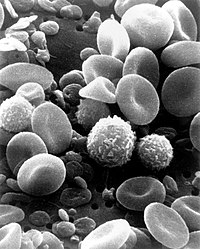
Photo from wikipedia
Restriction of oxygen (O2) is present in chronic lung infections with aggregated bacteria, but less is known about the physiological conditions during acute lower respiratory tract infections (LRTI). Polymorphonuclear leukocytes… Click to show full abstract
Restriction of oxygen (O2) is present in chronic lung infections with aggregated bacteria, but less is known about the physiological conditions during acute lower respiratory tract infections (LRTI). Polymorphonuclear leukocytes (PMNs) can deplete O2. Accumulation of highly pathogenic bacteria evading both the immune system and antibiotics is hence the clinically most important characteristic of O2 restriction. We hypothesize that O2 restriction is part of a stereotypical host response no matter type of infection. Our aim is to investigate how O2 depletion caused by PMNs affects the bacterial pathogenicity during acute and chronic pneumonia. The overall aim is to elucidate the role of anoxic conditions during acute and chronic bacterial lower respiratory tract infections. We include patients with clinical suspicion of pneumonia. Expectorated sputum samples are collected daily. Measurements of O2 profiles in sputum are performed together with PMN concentration determined by flow cytometry. Isolation of O2 consumption by the respiratory burst and aerobic respiration is established. Establishment of anoxic conditions was shown in sputum samples with increased PMNs/ml (P=0.028, n=17). Delayed O2 depletion was shown in sputum samples with inhibition of the respiratory burst. The results demonstrate that sputum from patients with acute LRTI contains active O2 depletion that is associated with PMN activity leading to anoxic conditions. Investigating how the physiological changes affect the bacterial pathogenicity during pneumonia may potentially allow us to develop new treatment strategies with supplemental O2 to increase the bacterial susceptibility to antibiotics.
Journal Title: European Respiratory Journal
Year Published: 2017
Link to full text (if available)
Share on Social Media: Sign Up to like & get
recommendations!